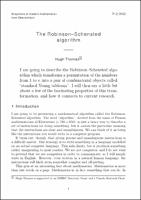| dc.contributor.author | Thomas, Hugh | |
| dc.contributor.editor | Munday, Sara | |
| dc.contributor.editor | Randecker, Anja | |
| dc.date.accessioned | 2022-05-06T08:41:09Z | |
| dc.date.available | 2022-05-06T08:41:09Z | |
| dc.date.issued | 2022-05-06 | |
| dc.identifier.uri | http://publications.mfo.de/handle/mfo/3940 | |
| dc.description.abstract | I am going to describe the Robinson–Schensted algorithm which transforms a permutation of the numbers from 1 to n into a pair of combinatorial objects called “standard Young tableaux”. I will then say a little bit about a few of the fascinating properties of this transformation, and how it connects to current research. | en_US |
| dc.language.iso | en | en_US |
| dc.publisher | Mathematisches Forschungsinstitut Oberwolfach | en_US |
| dc.relation.ispartofseries | Snapshots of modern mathematics from Oberwolfach;2022-02 | |
| dc.rights | Attribution-ShareAlike 4.0 International | * |
| dc.rights.uri | http://creativecommons.org/licenses/by-sa/4.0/ | * |
| dc.title | The Robinson–Schensted algorithm | en_US |
| dc.type | Article | en_US |
| dc.identifier.doi | 10.14760/SNAP-2022-002-EN | |
| local.series.id | SNAP-2022-002-EN | en_US |
| local.subject.snapshot | Algebra and Number Theory | en_US |
| local.subject.snapshot | Discrete Mathematics and Foundations | en_US |
| dc.identifier.urn | urn:nbn:de:101:1-2022112209191319064337 | |
| dc.identifier.ppn | 1823154727 | |


